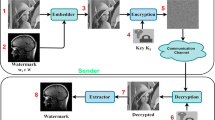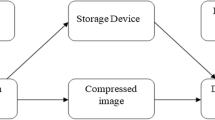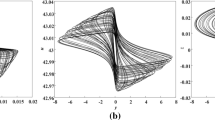Abstract
Matrix coding based data hiding (MCDH) using linear codes (syndrome coding) is an efficient coding method for steganographic schemes to improve their embedding efficiency. Hamming code data hiding (HDH) is a well-known MCDH using a covering function COV (1, n = 2k − 1, k). Afterwards, Hamming+ 1 DH (H1DH) was proposed with good embedding efficiency. However, these two previous approaches, HDH and H1DH, are not efficient for a large amount of messages. To tackle this problem, Yang et al.’s proposed Hamming+ k DH (Hk DH), which enhance the extra one embedded bit in H1DH to k embedded bits in the Hk DH. In this paper, we extended the Hk DH to the Hamming+ k with m overlapped pixels (Hk_mDH). The proposed Hk_mDH adopted pixel overlapping approach, optimal pixel adjustment process (OPAP), and Least Significant Bit (LSB) substitution. Experimental results demonstrate that our Hk_mDH has better embedding rate (ER) compared with previous schemes. In addition, we have proved that our Hk_mDH has excellent theoretical estimation of average mean square error.








Similar content being viewed by others
References
Bender W, Gruhl D, Morimoto N, Lu A (1996) Techniques for data hiding. IBM Syst J 35(3-4):313–336
Bierbrauer J, Fridrich J (2008) Constructing good covering codes for applications in steganography. Transactions on Data Hiding and Multimedia Security III 4920:1–22
Chan CK, Cheng LM (2004) Hiding data in images by simple LSB substitution. Pattern Recogn 37(3):469–474
Crandall R (1998) Some notes on steganography. http://dde.binghamton.edu/download/Crandall_matrix.pdf. Accessed 31 May 2018
Fridrich J, Goljan M (2002) Practical steganalysis of digital images - state of the art. In: Proceedings SPIE photonics west, electronic imaging , security and watermarking of multimedia contents. San Jose, California, January 1–13, vol 4675
Fridrich J, Lisoněk P, Soukal D (2007) On steganographic embedding efficiency. Lect Notes Comput Sci 4437:282–296
Image database ref., http://sipi.usc.edu/database/database.php? volume=misc. Accessed 31 May 2018
Kim C (2010) Data hiding based on compressed dithering images. Advances in Intelligent Information and Database Systems 283:89–98
Kim C, Shin D, Yang CN, Chou YS (2018) Improving capacity of Hamming (n, k)+ 1 stego-code by using optimized Hamming+k. Digital Signal Processing. https://doi.org/10.1016/j.dsp.2018.03.016, pp 1–9 (online 2 April)
Kim C, Yang CN (2016) Data hiding based on overlapped pixels using Hamming code. Multimed Tools Appl 75(23):15651–15663
Mielikainen J (2006) LSB matching revisited. IEEE Signal Proc Let 13(5):285–287
Stanley CA (2005) Pairs of values and the chi-squared attack. http://citeseerx.ist.psu.edu/viewdoc/summary?doi=10.1.1.146.5017,1-45. Accessed 5 May 2018
Westfeld A (2001) F5 - a steganographic algorithm: high capacity despite better steganalysis. In: Proceedings of the 4th international workshop on information hiding, pp 289–302
Xia Z, Wang X, Sun X, Liu Q, Xiong N (2016) Steganalysis of LSB matching using differences between nonadjacent pixels. Multimed Tools Appl 75 (4):1947–1962
Yang CN, Hsu SC, Kim C (2017) Improving stego image quality in image interpolation based data hiding. Computer Standards & Interfaces 50:209–215
Yang CN, Ye GC, Kim C (2011) Data hiding in halftone images by XOR block-wise operation with difference minimization. KSII Trans Internet Inf Syst 5 (2):457–476
Zhang R, Sachnev V, Bakke BM, Kim HJ, Heo J (2012) An efficient embedder for BCH coding for steganography. IEEE T Inform Theory 58(12):7272–7279
Zhang W, Wang S, Zhang X (2007) Improving embedding efficiency of covering codes for applications in steganography. IEEE Commun Lett 11(8):680–682
Zhang X, Wang S (2006) Efficient steganographic embedding by exploiting modification direction. IEEE Commun Lett 10(11):781–783
Zhang X, Zhang W, Wang S (2007) Efficient double layered steganographic embedding. Electron Lett 43(8):482–483
Zhang Y, Jiang J, Zha Y, Zhang H, Zhao S (2013) Research on embedding capacity and efficiency of information hiding based on digital images. Int J Intell Sci 3:77–85
Acknowledgements
This work was supported by the Basic Science Research Program through the National Research Foundation of Korea (NRF) funded by (2015R1D1A1A01059253), and was supported under the framework of international cooperation program managed by NRF (2016K2A9A2A05005255). Also, it was supported in part by Ministry of Science and Technology (MOST), under 105-2221-E-259-015-MY2.
Author information
Authors and Affiliations
Corresponding authors
Additional information
Publisher’s note
Springer Nature remains neutral with regard to jurisdictional claims in published maps and institutional affiliations.
A preliminary conference version of this paper appeared under the title “Capacity Enhancement of Hamming+k Data Hiding By Pixel Overlapping Approach,” in IEEE Proc. of 17th IEEE International Conference on Communication Technology (ICCT 2017), Chengdu, China, 2017.
Rights and permissions
About this article
Cite this article
Kim, C., Shin, D., Yang, CN. et al. Generalizing Hamming+k data hiding by overlapped pixels. Multimed Tools Appl 78, 17995–18015 (2019). https://doi.org/10.1007/s11042-018-7101-3
Received:
Revised:
Accepted:
Published:
Issue Date:
DOI: https://doi.org/10.1007/s11042-018-7101-3




